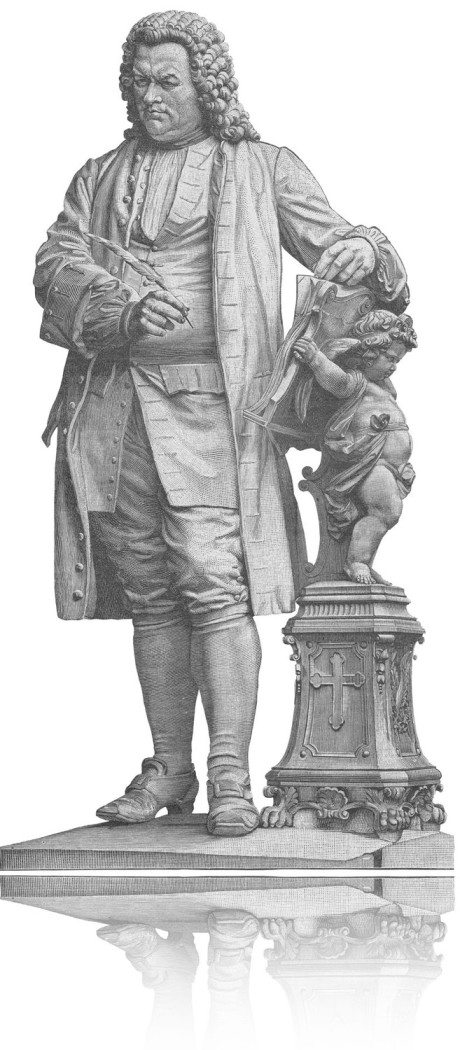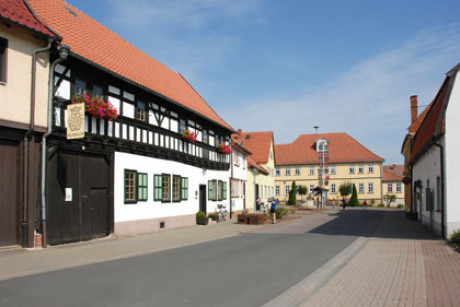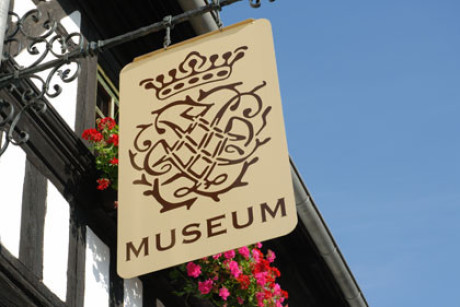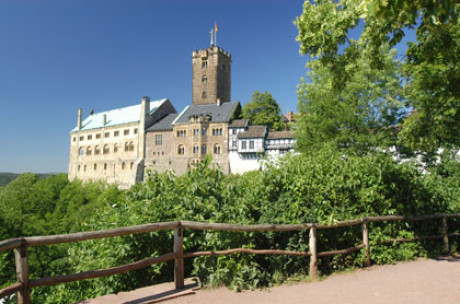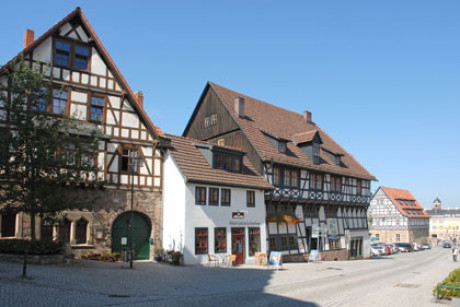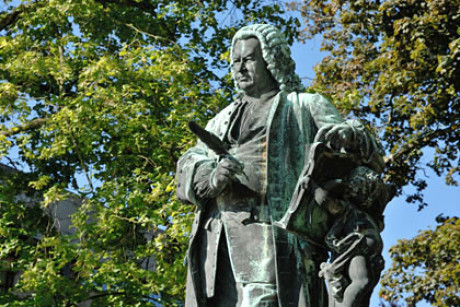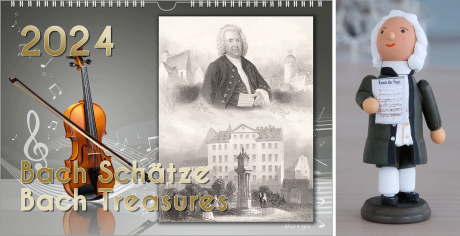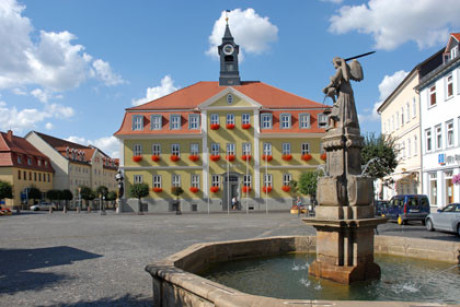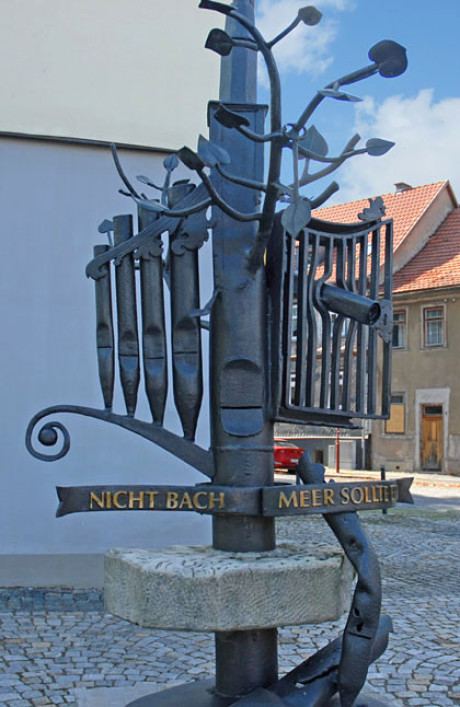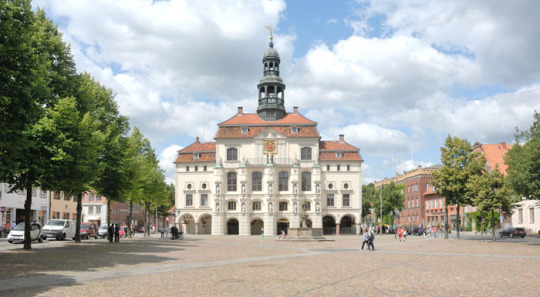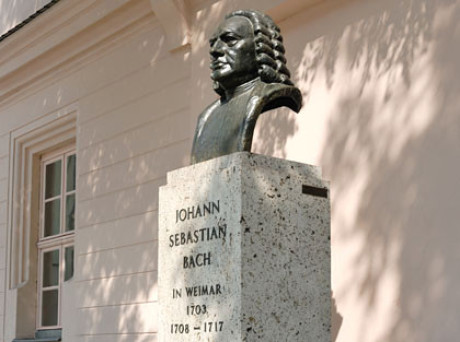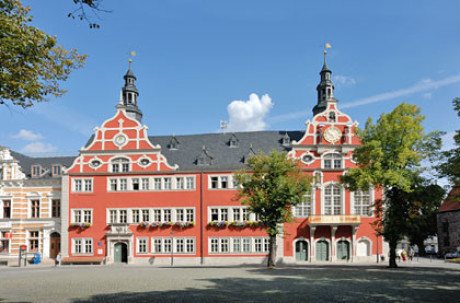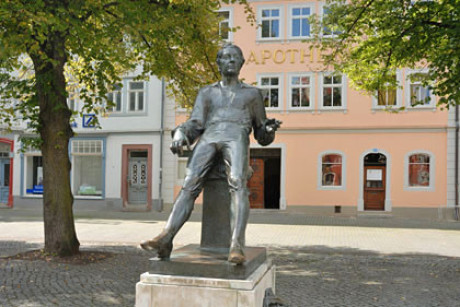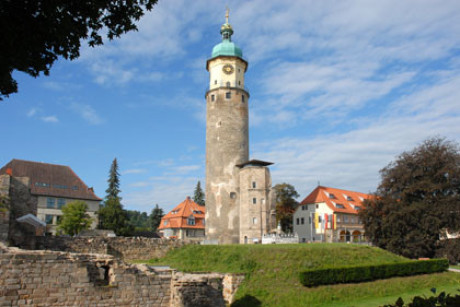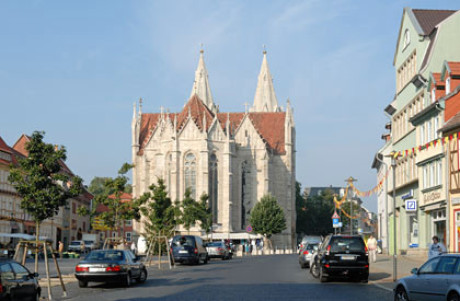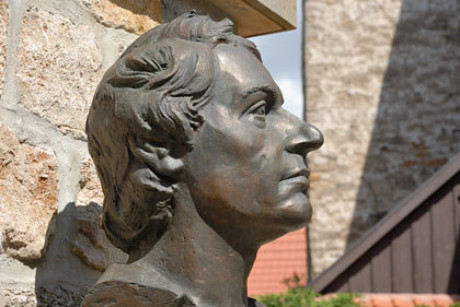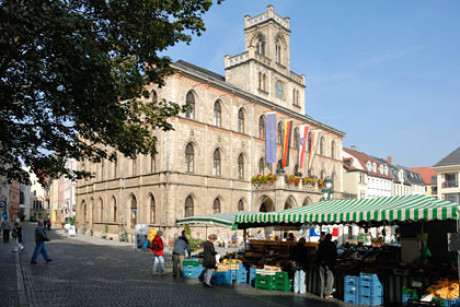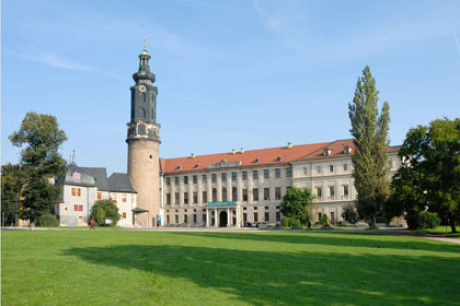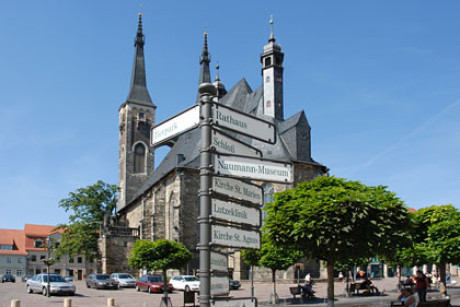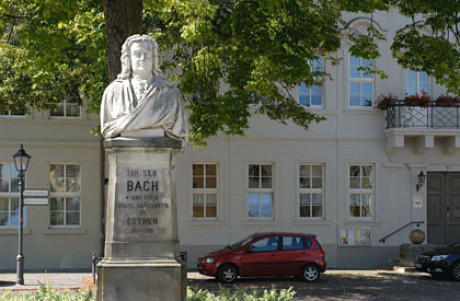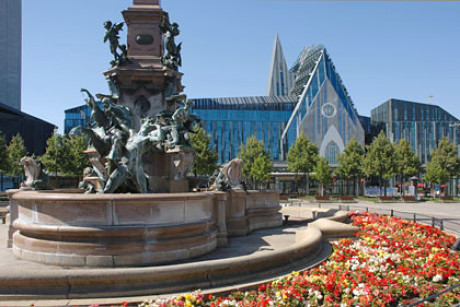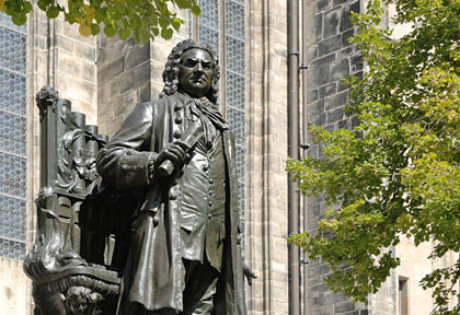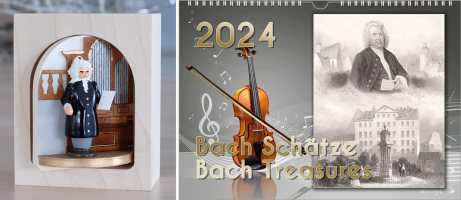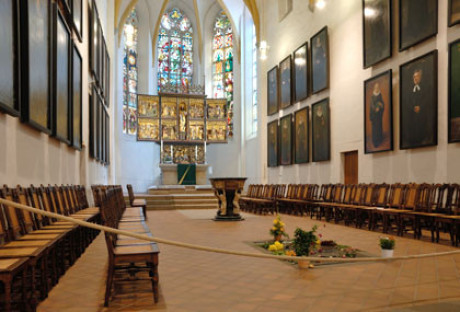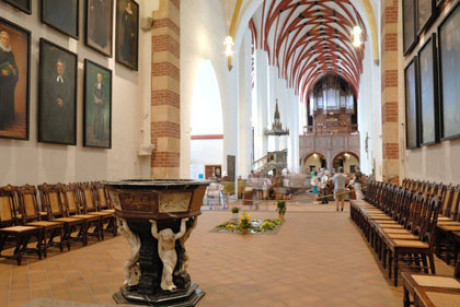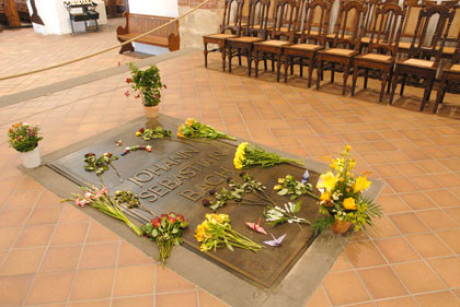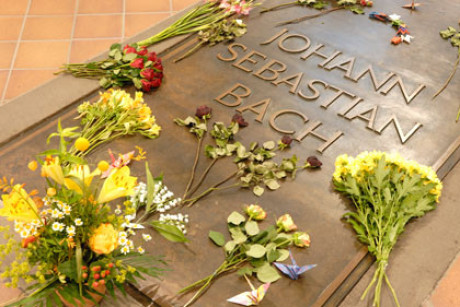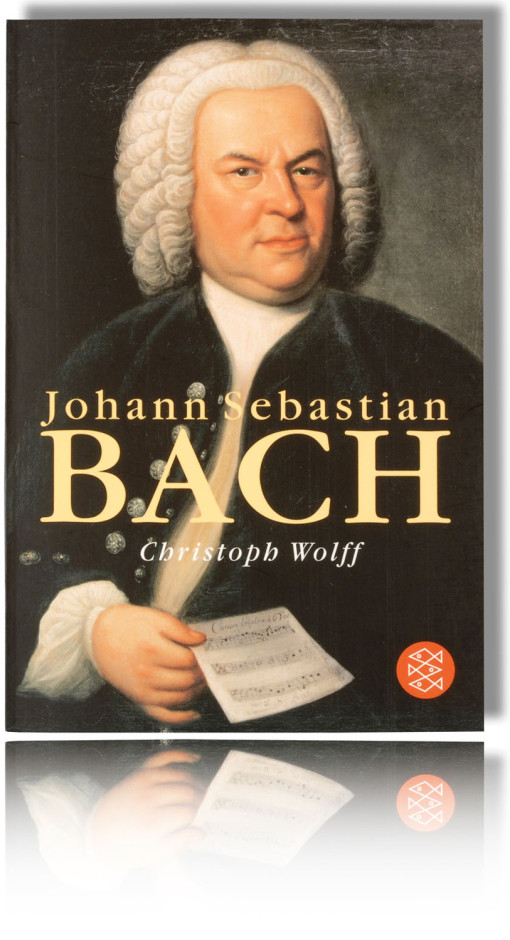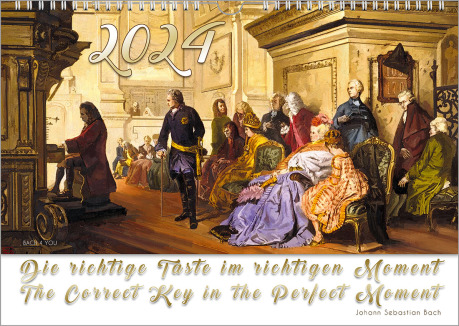Johann Sebastian Bach: A Short Biography in 25 Minutes
Johann Sebastian Bach, like he is located right of the Bach Museum and the Bach House as the third landmark of the ensemble in the Bach city of Eisenach, Thuringia. Here you see a steel engraving matching the third longest of my short biographies of Johann Sebastian Bach.
A Bach Short Biography With Music – Just Try It a Different Way!
Switch on your speakers and add the heaven like the music of Johann Sebastian Bach to this little short biography. And turn down the loudness – that is to say, play it very silently – just make it background music while you read. In this short biography on "Bach on Bach" I provide one beautiful work after another. Including little rest periods between the works and fading music at the end of every piece. Now just let yourself be entertained by two Bachs.
At this Bach location in Thuringia, the story about the family of musicians of Johann Sebastian Bach began: in Wechmar, directly located in the neighborhood of the Bach city of Gotha.
Wechmar is a Bach place, and Gotha is a Bach city too. However: none of those are "Johann Sebastian Bach Cities" – this hint just for the reason, to create no confusion.
Johann Sebastian Bach was a member of a family of musicians. More precisely: he was the member of one of the most famous families of musicians in the world. The family mainly operated in Thuringia, but in Saxony and Saxony-Anhalt and in the regions in a full circle around Erfurt too. The roots of the Bache, how they were called back then, point to Wechmar in Thuringia. This Bach location is a little community on the doorstep of the city of Gotha. Still today the genes of the descendants mirror the musicality – they live all over Germany, but as well in the Netherlands and even in the USA. Between the years 1600 and 1800 dozen Bache were cantors, organists, and town pipers. They played on weddings, festivals, baptisms, and funerals, they played in bands, or they built instruments. Veit Bach is the ancestor, and it still seems to be unclear, whether he came back from Hungary to Thuringia or whether the family originally came from Hungary. Records, however, show clearly, the Bache initially did not come from Hungary. It was Veit Bach who played a "Cithrinchen," which is sort of an early small cittern, to the beat of the mill. Son of Veit Bach was Johannes Bach, called Hans Bach too. In Wechmar, he wasn't just a baker, but he was a Spielmann too, a glee man in English. He is "Bach, the Spielmann," which is "Bach the glee man." Johann Sebastian Bach mentioned him too in his "Chronicle of the Musical Bach Family of Musicians," a collection of 53 Bachs, from whom most were musicians. He himself added up this list, which is still conserved today. However, it is in the handwriting of his granddaughter. Johann Sebastian Bach created this "Ursprung," which is "Origin" in English, like this document is called among Bach enthusiasts, in the year 1735, when Bach was 50 years of age.
In the Shadow of the Wartburg Castle: The Birth Town of the Master
The Wartburg Castle: it proudly sits on a mountain above the Bach city of Eisenach, the birthplace of Johann Sebastian Bach.
Johann Sebastian Bach was the youngest of eight children. However, three of them died until Johann Sebastian Bach was old enough to realize this tragedy. He made his first experience with death at the age of six years when his brother died. The father of Johann Sebastian Bach was Johann Ambrosius Bach, a glee man in Erfurt and later in Eisenach as well. He was a court trumpeter too, and this was in the band of the Dukes of Saxony-Eisenach. The mother of Johann Sebastian was Maria Elisabetha Bach, a née Lämmerhirt. The town, in which Bach is born is Eisenach. The Bach House there, however, is not the house of birth. But they assumed precisely this for many decades. When Bach was born, the Julian calendar still was a reference, and so for a long time, they were unsure when Bach was actually born. Finally, they agreed on March 21st of 1685, and that is true based on the Gregorian calendar. In the nowadays Luther Lane. Back then it was called the "Fleischgasse": there they assume Bach's house of birth. It's a pity; precisely this house doesn't exist anymore. Two days after his birth Bach was baptized.
Making Music with His Dad in Eisenach
The Bach city of Eisenach: the Luther House, very close to the marketplace. You walk just five to ten minutes from the Bach House to the marketplace. Of course, it depends, how fit you are.
Eisenach 1685. There were just 6,000 residents living in Eisenach. But a considerable music tradition was existing. Eisenach was residence city of the Dukes of Saxony-Eisenach. To play in their court band was exciting musicians in a wide circle. Famous names are connected with these musicians of the Dukes of Saxony-Eisenach, like Pachelbel, Eberlin, and Telemann as well. Johann Sebastian Bach spent a fraction of his childhood in Eisenach, and there he got his first instruction in the organ play. And that is to say from a cousin of his father, who was organist in the St. George Church. They assume that Bach already learned the basics to play the violin from his father. In the age of eight years, Johann Sebastian visited the Latin School in Eisenach, where already Martin Luther went to school earlier.
Early Busy – Early Alone
The mother of Johann Sebastian Bach died in May of 1694 when he was nine years old. Shortly after that, his father Ambrosius married again. It was the widow Barbara Margareta Bartholomaei, a nee Keul. But a few months after the death of his mother Johann Sebastian's uncle died too. Because both twin brothers, his father, and his uncle, were so similar, this incident dropped his father in such misery, that he died shortly after that as well. So, Johann Sebastian Bach was already a full orphan at the age of ten years. The second wife of Ambrosius Bach would have loved to do the job of her husband as a gleeman together with the town piper apprentices of the city of Eisenach, but she didn't get permission for that from the town council. That is why she couldn't feed and support Johann Sebastian and his siblings anymore. After all, there were four kids, which had survived from the first marriage of Ambrosius. Johann Sebastian moved in with his older brother Johann Jacob to his oldest brother to Ohrdruf.
It is really impressing: the Johann Sebastian Bach Monument. In the Bach city of Eisenach at the so-called Frauenplan, a square close to the city center this monument is one highlight of the "Bach ensemble" together with the Bach House and the Bach Museum.
Advertisement
Bach Calendars: You Won't Find More Elsewhere in the Universe
Ohrdruf – The Journey of Life Goes On
Johann Sebastian Bach's oldest brother was thirteen years older. Johann Christoph Bach, at that time, was organist at the St. Michaelis Church in the little Bach city of Ohrdruf. From that moment on, he overtook the education and the musical education of his youngest brother. He focused on keyboard instruments and at the latest here started Bach's passion for music and for instruments in general. It was in Ohrdruf that Johann Sebastian Bach not only did his first practice on the organ, but he learned about her construction and her mechanic as well, which was entirely crucial for his later career.
Starting 1697 the organ at St. Michaels Church in Ohrdruf was rebuilt, and they assume, that Bach here as well learned more details, which were of great importance for him later. In the first years of his career, they definitely did appreciate his expertise as an organ building specialist, and he once would play this instrument, like no person after him in the world. Johann Sebastian's brother was working on this rebuilding of the organ, and under his watch, young Johann Sebastian was of course permitted to play this instrument.
In addition, young Johann Sebastian Bach sang in the choir. Bach visited the school, better the Lyceum, until the so-called Prima. It's handed down, that Bach had good results in the school of Ohrdruf. Here he met his friend George Erdmann, who played a crucial role in three periods of Johann Sebastian Bach's life. When they wanted to analyze Johann Sebastian Bach's success later together with him, a statement of Bach is handed down: "I had to be diligent early, those who are diligent like me, might get that far too." The subjects back then were Latin, Greek, mathematics, and geography, catechism and religion – almost without saying – the Protestant faith. A student grant made it possible that Bach could support the financial situation of the family of his oldest brother. As his brother himself had to feed already a few persons. As compensation for those students who received these grants had to teach the children of those parents, who provided these financial resources.
Cozy, but absolutely worth a visit: the Bach city of Ohrdruf. Ohrdruf is the second station on the journey through the life of young Johann Sebastian Bach.
It was in this period in Ohrdruf, when a small enjoyable story happened. It's reported in the famous necrology on Bach. The necrology was back then what today is an obituary. This necrology, however, was published to a broad public not earlier than four years after Bach's death, that is to say, 1754.
Johann Sebastian Bach wanted to copy a collection of music pieces of back then famous musicians. But his oldest brother, who wanted to avoid an excessive demand of Johann Sebastian rejected this desire. He locked the note booklet in a closet. However, it was a piece of furniture with iron bars, through which a little child's hand would just work through. So young Johann Sebastian waited for many full moon nights, as only in a full moon night he had enough light to read and to copy all these music pieces. He crept from his bedroom to the little closet. He took the note booklet out, and he copied it. In many nights. After that – after he had accomplished his goal – he replaced the booklet in the closet. However, when Johann Sebastian Bach was practicing one day too absentminded from the copies, his oldest brother realized what had happened, when he returned home earlier than expected. He took the copy away from his little brother, and he never returned it. Never ever. But even this action didn't start a fight between the two Bach brothers. Both kept in best contact until his brother's death. Even more: like his oldest brother helped Johann Sebastian in big need, Johann Sebastian offered a home to his brother's sons for four years later.
One great composer about the other great composer. Ludwig van Beethoven didn't just say these short and concise words about Johann Sebastian Bach: this is one monument of two honoring the Bach Family in the Bach city of Ohrdruf.
From Ohrdruf: Northbound
The loss of his grant came unexpectedly for Johann Sebastian in Ohrdruf, and without this money, his oldest brother couldn't feed him despite hardest need. That was the reason. However it was not the only reason, Johann Sebastian Bach decided – he was fourteen years old at that time – to leave to Lueneburg, together with his friend George Erdmann, to the next chapter in his life. It's handed down that there were family connections existing to Lueneburg back then and the academic level of the Particular School was much higher than the one of the Lyceum at Ohrdruf. The school cantor on Ohrdruf, Herder, had studied in Lueneburg as well. That was at the Michaelis School too. Quite sure, Herder reported of his time in Lueneburg, in the so-called "High North of Germany." Lueneburg was "abroad" back then. Johann Sebastian Bach got a grant there too, what guaranteed Bach food and a roof over his head. He and Erdmann hiked to Lueneburg, after all a distance of almost 220 miles.
Lueneburg isn't just any city in the Bach history. Lueneburg is a Bach city – and it's even more: it's a real "Johann Sebastian Bach City."
Even Without GPS: First to Lueneburg and After that Back to Thuringia
It is known today, that Johann Sebastian Bach took his violin with him to Lueneburg. First records regarding Bach, and as well regarding his best friend George Erdmann, are found in the so called "Mettengeldzahlungen" in Lueneburg, a type of payment which students received for performing music: this is recorded on April 3rd, 1700. Both friends agreed to do this so called "Metten Service." For this obligation, they received money and food, and they didn't have to pay for lodging. So, with this "job," Johann Sebastian Bach was the first in the family of musicians, who decided for a higher school education instead of a musical education. He qualified – as well as a first member of the family - even for a study at a university. He finished – almost without saying – school in Lueneburg in 1702 with a big success. It's George Boehm, who impressed Bach in that time much. He was as well a musician at that time plus he was a cantor at St. Johannis in Lueneburg. His influence on Bach's work is assumed on scientific analyses until today. Of course, nobody knows for sure. At least Bach himself left a hint to Boehm on one of his works: "Boehm descriptum ao. 700, Lunaburgi". Lueneburg is located right on the doorstep of Hamburg, on the river "Elbe," and the distance to the so called Hanseatic City was with some 37 miles no challenge, compared to the way from Ohrdrurf up north. So, Bach hiked to Hamburg to listen to the organ play of Johann Adam Reincken. Of course, Johann Sebastian Bach hiked to Hamburg. Reincken was organist at St. Kathryn's Church. Bach wanted to learn more about his organ play. The organ in St. Kathryn's Church was one of the most beautiful organs all over Northern Germany, and this organ left a big impression on Bach.
Back to Lueneburg. The mentioned necrology tells from this era, that Bach " ... by listening to the famous band, which the Duke of Celle recreated and which was composed mainly by Frenchmen to educate himself in the French taste by listening to them several times ...". This band played in Lueneburg. In the residence of Duke Georg Wilhelm Bach was able to listen to this music. And he was able to study their play.
Easter 1702 until beginning of the year 1703 they didn't know where Bach actually lived, after he returned from Lueneburg when he had finished his school time and again had hiked the 220 miles south to Thuringia. One reason was that after his education and his obligations he had lost his grant and he would have had to pay for food and for at least one room to live in. A temporary first home back in Thuringia is what they assume with his older sister in Erfurt. Or maybe he was moving in with his oldest brother in Ohrdruf again. It is mentioned in a document that Bach applied for a first job as an organist in Sangerhausen. The town council decided to give him the job. However, the duke there, Johann George of Saxony-Weissenfels, decided for a different musician, not respecting the vote of the council of Sangerhausen. He gave this job to a young court employee and later opera composer Augustin Kobelius.
Weimar – Bach's First Short Stopover
In March 1703, maybe a few days earlier, Johann Sebastian Bach started his time as a footman and violinist in the band of Sovereign Johann Ernst of Saxony-Weimar. When he checked on an organ in Arnstadt, where Bach was before his first "employment" back in Thuringia. In a time, when he had not yet a job after his return to Thuringia. But Bach had enough time, to apply for a job here and there. So he managed to make a first relationship to the council of Arnstadt.
Johann Sebastian Bach worked in Weimar two times in his life. If you try very hard, you will find his monument there.
Arnstadt – Our Bach City No. 1
On August 9th, 1703 – that is to say just four, respectively five months after he started to make music in Weimar – Bach got first "real" employment in Arnstadt. And that was without any more audition: it was the approbation as the organist in the New Church in Arnstadt. His salary was, based on Bach's age, for his experience and as well compared to the salary of his predecessor unusually high. 50 florins as a standard wage plus 30 florins for food and lodging. First of all, he was only responsible for the organ play. Later they obligated him for cooperation with the choir of the local Lyceum. They assume that Bach already met his second cousin Maria Barbara in Arnstadt. Maria Barbara was the daughter of the very well-known organist Johann Michael Bach in the community of Gehren. Whether they met at that time, or whether Bach met Maria Barbara already on one of the yearly family gatherings earlier in life, is not known – that remains a secret until the present day. At least it is very probable that he either fell in love with her in that era when he worked in Weimar before or in the time in Arnstadt.
Our hearts beat for this Bach city. We are excited for Arnstadt. And that is the view, how Johann Sebastian Bach looks at the town hall still today.
Advertisement
Actually Thousands of Cool Bach Gifts
Johann Sebastian Bach and the "Longest Vacation in the World" Back Then
Still today one event in the Bach history is of highest musical interest, as well as a reason to fight for some biographers in several centuries. In October 1705 Bach wanted to hike to Luebeck. After all, it's a distance even farther than from Ohrdruf to Lueneburg. Actually, it's almost 300 miles. Bach wanted to travel to Luebeck, to listen to the back then already famous Dieterich Buxtehude plus to study him. After all, Bach knew very well, how long the hike to Luebeck would last – in fall, with already short days and bad weather. That meant soaked, that is to say, silted roads and ways. Plus the way back would be even worse, as it would have been in the deepest winter, that is to say after the end of the planned and applied visit in November. When the weather would have been even worse with snowy and icy and silted roads. Plus even shorter days and less daylight.
Bach, however, applied for four weeks of vacation - and got the permission. Whether he didn't plan to be back on time in advance, or whether there were more and different reasons ... it is at least worth today, to think about the person Johann Sebastian Bach for a moment. Fact is, in Arnstadt he had installed a very qualified representative for the time of his absence. But the reality is as well, that he returned as late as January back to Arnstadt. A delay of approximately eight weeks. Of course, Bach got deep impressions when he studied the play of Buxtehude and he probably even played on the famous, old "Death Dance Organ at St. Marien". However, in this time when Bach visited Buxtehude, his musical ambition grew even more significant. Still today you can clearly recognize the influence of the time with Buxtehude in Bach's first organ works. Buxtehude was as well impressed by Johann Sebastian Bach. He actually was excited. And because Buxtehude was already well advanced in years, and it was time to care about a follower, Johann Sebastian Bach was Buxtehude's first choice. However, it was common back then with the adoption of an office, to marry the daughter of the current organist as well. Because Buxtehude's daughter was ten years older than Johann Sebastian Bach and maybe for very different more reasons – they don't know that until today – Bach decided to return back to Thuringia. Where Maria Barbara awaited him already.
Really cool how young Johann Sebastian Bach is hanging around right in front of the town hall of Arnstadt. His viewing direction? Exactly direction town hall of the Bach city, like you, can see it in the last pic.
Who the Heck Is Geyersbach?
It was in the Arnstadt period when one spectacular event added to the rare knowledge around the person of Johann Sebastian Bach through the centuries and to decorate this characterization. Bach was upset about one choir student, who disturbed the choir practice for the purpose. Bach called him a "Zippelfagottist," back then really a little too harsh expression. A few days later, in the dark – Bach was walking back home from a concert on foot – this student with the name of Geyersbach approached him with his friends. Those choir students all had clubs with them. Bach was supposed to apologize. But Bach refused although he was inferior. Because it was very dangerous for Bach to argue against six of his students, as Bach needed his hands undamaged, he decided to unleash his epee. This epee was part of the costume of all musicians at the court of Arnstadt back then. He unleashed his epee – and it's handed down, that he didn't use it. Again, it's not unclear, whether he used it. It's handed down, that he actually didn't use it. The students and Geyersbach, however, took to their heels. So much about the story, about Bach and about his epee.
It's true, even at night time and of course not in broad daylight too, Arnstadt gives you no dangerous feeling. However, if you call a troublemaker "Zippelfagottist" ...
From Arnstadt to Muehlhausen
They know that Bach composed his "Capriccio soprano la lontananza del Fratello dilettissimo" in the year 1706. Probably to say goodbye to his brother Johann Jacob. Johann Jacob joined the entourage of King Carl XII of Sweden in Stockholm, and he accompanied him on his crusades in the Nordic War.
The late return of Johann Sebastian Bach from Luebeck was punished by the council of Arnstadt only with an objection. However there was one more dispute between Bach and this committee. They criticized the behavior of Johann Sebastian Bach against the choir plus the way, how Bach played the organ. And so he was warned officially, not to play the interludes, the ornaments and the modulations "... too strangely and to confuse with that behavior". Plus they accused him of an incident, which was absolutely a monstrosity back then. Johann Sebastian let a "strange damsel" perform on the gallery of the church. That was unimaginable in the time back then. Whether this "strange damsel" was Bach's second cousin Maria Barbara Bach, is only assumed. However it's not confirmed and actually Maria Barbara was well known in Arnstadt at that time. Nothing however is proven. Because the relationship with the council developed worse, young composer Johann Sebastian Bach was attracted to the next city of his career. He was attracted to the city of Muehlhausen, some 50 miles away from Arnstadt. Muehlhausen in Thuringia is still today called the "City of Towers and Gates".
Muehlhausen – a Bach city with impressing churches: this was Bach's destination after there was too much friction with the town council of Arnstadt.
On April 24th, 1707 Johann Sebastian Bach auditioned in Muehlhausen. Muehlhausen not only was an Imperial City, but it was Hanseatic City too. On July 1st, 1707 he started his employment there. That was in the impressing Divi Blasii Church. As an organist. His salary raised, and it's worth mentioning, that Bach again got more money, and that is to say not only more money than in his position before, that went without saying. However, he got more money than his predecessor in this office. 85 florins, plus natural produce and more ancillary income from the other churches of Muehlhausen. Bach found the time perfect to marry Maria Barbara, and it attracts attention, that Bach married neither in Muehlhausen nor in Arnstadt. However, he married his second cousin Maria Barbara Bach in the nowadays "Traukirche," the so-called wedding church of Johann Sebastian Bach in Dornheim. Dornheim is a tiny community right on the doorstep of Arnstadt.
Johann Sebastian Bach in Dornheim. An insider tip: if your trip brings you to the Bach City of Arnstadt, "just include Dornheim." That is "BOGO," so to speak: buy one, get one free. Dornheim is located only two minutes by car from Arnstadt and is a cute Bach place. Two minutes from the city limit of Arnstadt to the "community limit" of Dornheim.
A first work, which is generally linked to Bach's name surely is the "Ratswechsel-Kantate," which is the "Town Council Change Cantata," which Johann Sebastian Bach composed as a request for the ceremonial change of the town council of the city of Muehlhausen. The official name of this work is God is my King, it is work 71 in the Bach Werke Verzeichnis, the "Bach Works Register." Notable is that this is the only printed composition from that time. This is the case because the print of a musical work was a costly issue back then.
Weimar Calls – But Seriously Now
The town hall of the Bach city of Weimar: just a stone's throw away from the back then apartment house of Johann Sebastian Bach.
In June 1708 the renovation work of the organ in Weimar was almost completed and Johann Sebastian Bach in his function as an organ building expert travelled to the court of Duke Herzog Wilhelm Ernst to Weimar. Duke Ernst listened to Bach's music, he was impressed by Bach's performance and he offered Bach as much as 150 florins. Again plus natural produce - a generous offer - even if Bach himself developed back from a free person in the Imperial City of Muehlhausen in the past months to a bondman, that is to say not to an employee. A gigantic fire in the past months with hundreds of houses and stables burnt down led to a dramatic rise of the cost of living in Muehlhausen, Johann Sebastian Bach decided again, to continue his professional journey. Just one month after his prelude for the sovereign and as early as one year after he started working in Muehlhausen, he already left that town. The follower of Johann Sebastian Bach was Johann Friedrich Bach. It's mentioned here, that "Bache" – that is what members of that family were called back then – as members of that family, just by affiliation to that family were a guaranty for musical quality. Bach for that reason was one of the first, very early brand names. Even long after a Bach was in office, they called those musicians Bache. However, not like in Arnstadt, Bach left Muehlhausen and the town council in a good relationship. The major stated: " ... if we weren't able to hold him, we just let him go ..." 1709 and 1710 this committee in Muehlhausen asked their former cantor again to compose for the change of the city council. Both works have even been printed and the town council paid for it. That is what records of the city tell. However, those two cantatas, like so many other works of Johann Sebastian Bach, are lost.
In the first half of July 1708 Johann Sebastian Bach moved to Weimar. Maria Barbara was pregnant for the first time and on December 29th their first child was born. It was baptized with the name of Catharina Dorothea. During this second period in Weimar five more children were born. Two died during their birth, the others got, almost without saying, an exclusive education in school and all of them visited the university after school. Bach composed the biggest part of his organ work in that time. Toccatas, Fugues – and the Orgelbuechlein, the "Little Organ Booklet" a collection of organ preludes, came into being.
In February 1713 Bach played for the festivities of Duke Christian of Saxony-Weissenfels in the city of Weissenfels, and they assumed, that the "Jagdkantate", the "Hunting Cantata" was performed there for the first time. This cantata was Bach's first secularized cantata. There are almost no churchly cantatas preserved from these early Weimar years. When Bach was offered the position of an organist at the St. Marie Church in the city of Halle at the end of this year, he hesitated for four full months. Finally he rejected this position in 1714. He himself was interested in that position and he travelled to Halle to perform an audition. What eventually lead to his rejection, is not known. Bach however told that the salary did not meet his expectations.
Bach Becomes Concert Master
The Town Palace in the Bach city of Weimar.
In March 1714 Bach was appointed concertmaster at the age of 29 years. Although his position was below the band leader and below the vice bandleader too, he received with this title a much higher salary than before – and as well as both band leaders too. However what came with the higher salary and the title was that he had to compose one churchly cantata all four weeks in addition to his church service. The first of those cantatas was performed precisely on March 1st in the year 1714, Palm Sunday, which is Lady Day too. It is the title "King of Heaven," be welcome. Bach composed at least twenty more works according to his contract, and all of them form the foundation of the "Leipzig Cantata Years" later. Which instruments Bach played with his Weimar court band, is not handed down. Because these historical notes and all records have burnt at the great fire of the Wilhelmsburg Castle in 1774.
Nine Years at Weimar End in Jail
Johann Sebastian Bach cultivated his connections in this Weimar era, in particular with musicians. It's important to mention the contact to the Dresden music director Johann George Pisendel, and they assume, that this acquaintance inspired Bach to compose the six sonatas and partitas. Aside from this, it should be mentioned again, that Bach, working for the Duke in Weimar was nothing but a bondman and not like in the Imperial City of Muehlhausen, a free man. On the wedding of Duke August on January 24th, 1716 in the city of Nienburg Bach met the nephew of his employer. It was young Sovereign Leopold of Anhalt-Koethen. Leopold was nine years younger than Bach. When in the year 1717 the Court Band Master in Koethen left his position, Bach signed a contract as band leader there, without talking to his employer in Weimar ahead. Talking back then meant to ask the duke – for permission – to let him go. When Bach wanted to "ask but later," he received no answer from his regent. Plus the duke rejected the request for a conversation. Bach, who was very upset about this situation and misbehaved, was immediately arrested and put in jail. Because of stubbornness. For as longs as four weeks. With that imprisonment, the Duke of Saxony-Weimar went down in history, not for his achievements, but solely for the reason he put the most exceptionally gifted musician on earth for one month. On December 2nd finally, Bach was released and fired out of favor - from prison and as well from his job in Weimar.
Advertisement
Please Support Our Bach Mission
Köthen – A Place for the Whole Bach Family plus JSB for Eternity
The Bachs really liked it in Koethen. Johann Sebastian Bach himself confirmed that he could really imagine himself living in that nowadays Bach city for his whole life.
Koethen was not only the new home for the family of Johann Sebastian Bach, but he was finally hired as a bandleader there. He now was director of the Koethen chamber musicians. There were excellent musicians working at the court. Plus Bach was excited by the performance of Sovereign Leopold, who participated himself in his orchestra as a violinist. Likeability between the two men was followed by friendship, and both musicians were very close. How close, is what we realize, when both siblings of the sovereign, August Ludwig, and Eleonore Wilhelmine were godparents of Bach's 1718 born son Leopold August. With his signature on his nomination document as a bandleader Bach, by the way, earned directly and right away 50 talers, that is to say in addition to his monthly payment of 400 talers and a little rental grant of 12 more talers.
The band in Koethen was unusual and excellent. With seventeen musicians it was a considerable number of artists compared to the importance and the size of the court. Some of those musicians had even played for King Frederick Wilhelm I. Alone from that fact it's clear, they must have had been excellent. Eight of these specialists even had soloist quality and the rank of a chamber musician. Plus the sovereign arranged for exquisite instruments: Bach for instance was instructed to travel to Berlin 1719, to buy a cembalo there.
Koethen: Both Heaven and Hell
Johann Sebastian Bach on the Bach Place in the Bach city of Koethen. Right in front of his former house in the city center.
In 1720 the famous work "Clavier Booklet for Anna Magdalena Bach", "The French Suites" and "The Well-Tempered Clavier" came into being. Plus uncountable more works. But in 1720 everything changed dramatically, when Johann Sebastian Bach returned after a trip of two months with his sovereign back home from Carlsbad. Maria Barbara had died in this time after a short disease in the age of just 35 years. It's not handed down what caused her death. And even worse: she had been buried meanwhile. Not earlier than after 18 months Johann Sebastian Bach married a second time. Some biographies tell the reason was to give his children a mother again and probably as well, because he needed support with his household. Other biographers disagree and state, that Bach surely had married a second time, because he had fallen in love again. His second wife, by the way, was a successful musician too. Plus Bach's children probably got used to the situation meanwhile, there was no mother around after such a long time and they got used to that situation. In December 1721 the wedding of Johann Sebastian Bach and the youngest daughter of the field trumpeter in the band of the sovereign of Saxony-Weissenfels, Johann Caspar Wilcke took place. In 1720 Anna Magdalena Wilcke had joined the musicians at the Koethen court as a soprano. Thirteen children had been born in the oncoming years and if you are interested now, what their names had been, you are invited to check that here and now. However five of these children died very early but anyhow the family grew year after year finally by seven persons. One of these children was mentally challenged from birth on.
What the "working crisis" might have caused, after Maria Barbara's death, as some of the Bach biographers saw it, is only assumed. Bach's fading excitement for Koethen probably had several important reasons, and it's unclear whether it was a "working crisis" or a depression, today you call it "burn out." However it's understandable: the missing churchly music which nobody needed in Koethen, the sadness connected to the remembrance of Bach to his time with Maria Barbara - Koethen kept this memory alive at each street corner – plus even when he married a second time because he had fallen in love again, the end of his first marriage was connected to a trauma.
Part of the musical heritage of this era is, like already mentioned, the "Clavierbuechlein," the "Clavier Booklet," which Bach arranged for his son Wilhelm Friedemann in 1720. Many of Bachs works from this era are lost. The crucial factor for Bach to leave Koethen finally was – amongst the reasons mentioned above - surely the marriage of his friend and employer Sovereign Leopold. Leopold had married around the same time as Johann Sebastian Bach. However, he had married a princess, which was not attracted by music at all. It was a woman, which was even described as an "amusa." And because Leopold's wife had no interest in music, and for that reason, she had, of course, no interest in Bach's music too, Leopold's interest in Bach's exquisite music faded from this very moment. Plus there was less money available for music. Finally, disputes between Reformists and Lutherans happened on a daily base in Koethen. Finally, there was a poorly managed Latin School, which explains Bach's considerations today.
A Position in Hamburg Coming with a Owing the Employer 4,000 Marks!
Already 1720, that is precisely in the year of the death of Maria Barbara, in Hamburg, the position of an organist became available: the one of St. Jacobi Church. Bach applied for this position and asked to perform an audition. The town council invited him; Bach performed the audition. However, he canceled his application after a short time later. The reason was that it was common at that time, "to buy into" such a position with a considerable amount of money. However it had paid off after a few years by the difference compared to the salary, the amount of 4,000 Marks and the size of Johann Sebastian Bach's family didn't let him decide for that option. Plus it was sure, that everything seemed uncertain after the death of Bach's first wife in those days.
Leipzig Forever
The Bach city of Leipzig: a metropolis, in which modernity, culture, music, and tradition bloomed together ever since.
In the musical city of Leipzig, there was a position vacant on June 5th in the year 1722. And that is to say an important position: the position of the Thomas Cantor. After a first audition – without Bach – three candidates of distinction remained. Those were bandleader Johann Friedrich Frasch, the music director Christian Friedrich Rolle and Georg Philipp Telemann. They offered Telemann a rise of his salary at once, so he remained in Hamburg in the North of Germany. The council of Leipzig contracted out a second audition, and Bach joined this one. Together with Georg Friedrich Kaufmann from Merseburg plus the band leader Johann Friedrich Graupner from Darmstadt. A fourth candidate was the organist of the New Church in Leipzig, Balthazar Schott. Kaufmann stepped back. The council decided for Graupner, not for Bach. Graupner, however, rejected too – he had to reject – because his release was refused. The Hesse Landgrave didn't want to let him go. And so, Johann Sebastian Bach became officially just as "third choice" the new Thomas Cantor of Leipzig. Correspondingly the records of the city confirm, that the council considered, that " ... if they couldn't get one of the best, they had to be happy with a man of moderateness." The title of the Sovereign Koethen Band Leader, however, is what Bach carried on and he had, on festive days, still contact with his friend, Sovereign Leopold, until Leopold died in the age of 42 years very early.
Johann Sebastian Bach Is Thomas Cantor
Johann Sebastian Bach in front of the St. Thomas Church in the Bach city of Leipzig.
At the end of May 1723, Bach began his office as the Thomas Cantor in Leipzig. He was cantor plus music director, so he was responsible for all four big churches in Leipzig - The St. Thomas Church, the Nikolai Church, the University Church and the Protestant-Reformed Church. However, he was also responsible for all of the smaller churches in Leipzig. Adding to that he had to prepare one cantata for each Sunday's service plus one for the holidays in the church year. Plus he was responsible for the musical education in the St. Thomas School. All residential school students were obligated, to support creating the service as choir members. However, the back then already for hundreds of years existing Thomas Boys' Choir was not the same as it is today. It was Johann Sebastian Bach who made this choir, what it is still today: one of the most famous boys' choirs in the world. Actually, to all these obligations he had to teach Latin too, but Johann Sebastian Bach engaged the vice principal of the school for that, for the half of his own salary. A really considerable part of his income generated Bach with the back then common wages for the compositions of cantatas for weddings, baptisms, and funerals. However, it has to be mentioned, that he not only had to feed a relatively large family with the seemingly high salary and the ancillary income but as well that the cost of living had been much higher in such a city compared to the cost of living in the manageable town of Koethen.
Today they assume, that Bach undoubtedly created one of his cantatas per week in the first years. Two complete years are handed down. Plus the necrology reports of three more. As a total, it's reported that it was 300 cantatas in that time, which Bach composed week by week, practiced and presented to the church community. 1723 the second version of the "Magnificat in Es-Major" came into being. On Good Friday of the year 1725, he met Christian Friedrich Henrici – a Leipzig resident as well - for the first time. Henrici was a poet and called himself Picander. Picander created the text for the "St. Matthew Passion", which was performed for the first time in the year 1727. In the daily newspaper, this event wasn't mentioned with one single word, although the "St. Matthew Passion" today for many people is the most considerable musical work of Christianity ever.
In the year 1729 Bach adopted the management of the "Collegium Musicum," which Telemann had founded in the year 1701. The "Collegium Musicum" was an ensemble of students, that performed German and Italian vocal music. Bach wrote several earthly cantatas. His "Peasants Cantata" and his "Coffee Cantata" are samples of the humorous touch of Bach's music. Once a week, during the Leipzig Fair even twice a week, nightly concerts were performed in the "Coffee House Garden" in the Zimmermannschen Caffee-Hauß. This house was completely destroyed in World War II.
Ernesti 1 – Gesner – Ernesti 2
Starting with the disregard of Bach by the council of the city of Leipzig, via almost outrageous contract conditions down to the permanent fights and frictions, life for Bach in the 27 years in Leipzig was a steady up and down in really long cycles. Local political frictions, problems with the competence, intrigues, turf wars and notably disinterest of his employer added to the challenges in Bach's everyday life. Plus Bach in the beginning faced a really incapable orchestra, secondly a choir, which was a real challenge and thirdly the school teaching.
Four strong parties fought and allied in Leipzig. These were the dignitaries who were in power, the Council of Leipzig, the principals of the St. Thomas School and the University. So Bach was doing better for a while, than worse again and sometimes even very bad. First there was the town council, which recruited Bach. Bach appealed the town council several times to change grievances. Next it were the principal of the St. Thomas School, he was Bach's direct supervisor. Already his first boss with the name of Ernesti caused Bach to think about leaving Leipzig again. The whole magnitude of Bach's depression is still shown today in his famous letter to his school friend George Erdmann, in which he reported, why he had left Koethen. Of course he reported too, how shabby they treated him in Leipzig. And he asked Erdmann emphatically, to be helpful with the search for a new job. Not earlier than after Principal Ernesti was replaced by his follower Johannes Matthias Gesner, it meant a few easy going years for Bach. However, after Gesner was appointed to Goettingen, there was a next principal, with the name of Ernesti of all names. The problems with both Ernestis were similar; the same name however was absolutely random, as both – "Ernesti 1" and "Ernesti 2" – were not related. Finally the University of the City of Leipzig was the fourth heavyweight in the cooperation and the conflict in this musical metropolis.
Peak of the fight between the principal of the St. Thomas School, the City Council and Johann Sebastian Bach was, if we want to connect all that fight to one special event, was the so-called "fight of the prefects", the Präfektenstreit in German. This fight did not only fill the records of the city of Leipzig immensly in that time, but as well many, many pages in hundreds of biographies for more than 250 years. Together with the hint, that Bach's once threw his peruke after a student, it lead to the statement – which is wrong in my opinion – that Bach had been a grumbler and a choleric person. Improper mentioned in this short biography I want to say, that a person like Bach could hardly think throwing a peruke would produce a sustainable impression on someone. If an expert like him, who wrote in the mentioned letter to Erdmann analogously, that some... " ... of his students couldn't sing one straight tone correctly ..." and you have to picture yourself those students in one room with the most exceptionally gifted person on earth, then you might understand, how even the calmest person once in a while tends to a slip. That this throw of his peruke would miss its mark is what Bach surely knew with the launch. What he didn't know is probably that even 1,000 years after his death people will whine about this incident. In this year the first, for a long time still unfinished version of the "H-Minor Mess" came into being. 1935 Johann Sebastian Bach composed the "Easter Oratorio".
Royal Polish Court Composer
In the year 1736, the "Fight of the Prefects" took place. Prefects lead the service in the four big churches of Leipzig. The prefects were older and matured students. Principal "Ernesti 2", whose responsibility this wasn't for sure, appointed one for personal reasons: "Krause 1". Firstly Bach accepted this. But when he was not happy with Krause's job, Bach fired him. To make it short: Principal Ernesti hired him again. Bach, however, fired Krause a second time, but finally, all other students were afraid to follow Bach's instructions and execute Bach's arrangements. So it happened, that not only Bach lead the service personally in that time, but as well complained to the council of Leipzig officially about that situation. Krause 2, the replacement for Krause 1, not related to each other like Ernesti 1 and Ernesti 2, was no real substitute for Krause 1. Bach complained – again – to the council. But the council didn't agree with Bach's opinion, as Krause 1 was son in the circle of the notabilities of Leipzig. Bach, however, was actually just interested in music, composing and service, but not in the political tactical maneuvering, the intrigue and the fight for rankings and positions. Bach more than ever was a political loser in those disputes. They positively "disassembled" the Thomas Cantor. Many biographers recognize – after this fight – a retraction of Bach from public appearance. Not with a big bang – it's more little by little. There is something marginal to mention. However, it is of very highest meaning for Bach. Namely, that he just in that era had received his long desired and applied honor of the king, to call finally himself "Royal Polish and Electoral Saxon Composer at His Court Band." There was no financial advantage coming with that, but the prestige was of benefit at Leipzig. Plus Bach now hoped that he was called to Dresden. However this hope – hadn't not come true.
Five Musical Sons – Four Famous Sons
In his time in Leipzig Johann Sebastian Bach was a private teacher in high demand for almost three decades. Often and for a long time, students lived together with his children in a large family under one roof with the Bachs. One of these students, Johann Christoph Altnikol, even married Bach's daughter Liesgen. For Johann Sebastian Bach it was important when it came to education, which was true not only for his own children but for all of his students as well, to educate them to become exquisite musicians and composers, both at the courts and in the church service. He managed that to perfection with four of his sons, of which at least five had a great musical talent. Four of them even got more famous at their time, even more, famous as their father Johann Sebastian Bach in Leipzig. Only one son, Bernhard, who became a musician first, gave the Thomas Cantor a hard time. One day he disappeared and even left his father quite a few dept, Bach, however, paid it back. So Bach was calling this child "his failed son" in one of his rare personal documents. Of course, Bach used own works for his education and collected them as Clavierübung 1 bis 4, which is "clavier practice 1 to 4" in English. Later he published them too.
As mentioned, some biographers believed to discover a slow-down in the work and creation of works of Bach. Others have - like always – an absolutely different opinion. In this decade Bach traveled much. During one of these trips, Anna Magdalena fell ill critically and with the remembrance and the loss of Maria Barbara Johann Sebastian Bach rushed back from a trip from Berlin to Leipzig. In 1741 his path led him to Dresden too. There he very probably handed the "Goldberg Variations" to Hermann Earl Keyserlingk. In 1742 Bach composed the "Peasants Cantata," still today very well-known by its name for the Earl of Dieskau. Finally, 1744 Bach published the second part of his "Well-tempered Clavier." In the year 1746, he ended his management of the Collegium Musicum.
Advertisement
So Many Cute Bach Gifts: the Bach Figures from the Erzgebirge
Bach figure, Bach bust and Bach statue ... 3 exciting suggestions, when you are looking for a Bach gift … learn more.
End of Advertisement
Two Great Personalities in History Meet
In the year 1747 finally, a very special trip crowned the life of Johann Sebastian Bach. King Frederick the Great invited Bach to Potsdam and Berlin, where, at the same time, Bach's son Carl Philipp Emanuel was a member of the king's court band. When Johann Sebastian Bach had arrived there, the king didn't leave him almost 15 minutes and ordered Bach, still in his travel clothes, to the palace. He introduced Johann Sebastian Bach to the small society, which regularly made music in the evenings: "Gentlemen, the old Bach is here." He asked Bach to improvise. On several instruments. And that is to say, after a theme, which the king had developed himself. Bach promised to compose according to this visit this theme in a fugue. That was supposed to be engraved in copper - an expensive endeavor at that time. Coming with this promise Bach developed the "Musical Sacrifice," a collection of two fugues, ten canons, and one trisonate. All reflecting the same theme. Plus Johann Sebastian Bach dedicated this work to the king. However, Bach didn't get any payment from the king – and the king didn't say anything about this gift too.
One of the last works which Bach composed was the "Art of the Fugue," which he revised until 1749 again and again. In that time he accomplished his famous "H-Minor Mess" too. However, he didn't write the last choral personally. He dictated it to his son in law Johann Christoph Altnikol: "Vor Deinen Thron tret' ich hiermit," which is: "I now step in front of your throne with this."
Blind
It is a fact that Bach increasingly suffered from eye disease in his last years. Today they assume eye cataract added to this fact. What caused the disease was not quite sure: a stroke or maybe diabetes. The last document from Bach dated back in 1749. Bach was short-sighted through his whole life and after the cataract now added, Bach decided to undergo surgery. At that time, a famous occultist, a so-called Starstecher – hard to translate this German word, maybe a cataract stinger comes close – the British John Taylor, was on a trip from London to Leipzig. He operated Bach. This surgery weakened Bach dramatically, and the medicine back then worsened Bach's constitution additionally. However, this surgery was unsuccessful. So John Taylor tried a second time – again without success. Bach wasn't able to work in the following half year, nor could he compose excitingly. In July finally, one morning, his eyes seemed to have recovered. Johann Sebastian Bach was able to see again. However a few hours later – on this very day – a stroke, probably a second one caused another dramatic setback to Bach's health. A short time later Bach was called to his highest ranking employer. It was the evening of July 28th in the year 1750, fifteen minutes before 9 o'clock.
Honor, to Whom Honor Is Due?
They didn't take much time and effort with the burial of Johann Sebastian Bach. They more or less hastily buried him, exhumed him later and buried him at a different insignificant place again. Later they exhumed him the next time and finally buried him at the position as the last resting-place, which matches the ability, the significance and the magnitude of the Thomas Cantor Johann Sebastian Bach: directly close to the Lord's table inside the St. Thomas Church of Leipzig.
The grave of Johann Sebastian Bach inside St. Thomas Church: thousands of Bach enthusiasts pilgrimage to this place in Leipzig.
A view in the direction of the nave of St. Thomas Church. You look from the Lord's table over Bach's grave. In the background, you can discover the organ.
The grave of Johann Sebastian Bach is decorated with flowers all year round. Lovers of Bach's music honor the composer even 250 years after his death.
His third permanent site and the final also. The grave of Johann Sebastian Bach in the St. Thomas Church in Leipzig.
Oblivion, Renaissance and for the New York Times Johann Sebastian Bach Is No. 1
Anna Magdalena spent the final ten years of her life in relative poverty. Bach's work, however, was – never ever for musicians, but for the broad public – lost. It just disappeared in a meaninglessness. Even worse, approximately ninety percent of his music for that reason was lost forever. Plus the remaining ten percent were lost for many decades. More than three-quarters of a century. Until Felix Mendelssohn Bartholdy, he was an exceptionally gifted composer too, and Bach enthusiast re-performed the "St. Matthew Passion" exactly – on the very day – 101 years after its first performance. Finally, over 260 years after his death, the New York Times voted Johann Sebastian Bach, the most significant composer of all times.
And now? What are you waiting for? Hurry to your book store and get a reasonable biography of Johann Sebastian Bach.
Advertisement
99 Music Calendars, Composers Calendars and Bach Calendars
100,000,000 music gifts? It is true … learn more.
Music gifts and gifts for big and little musicians: That is what a Bach calendar (picture above), a music calendar and a composers calendar is. Always three sizes. 2024 + 2025. To the shop.
End of Advertisement

